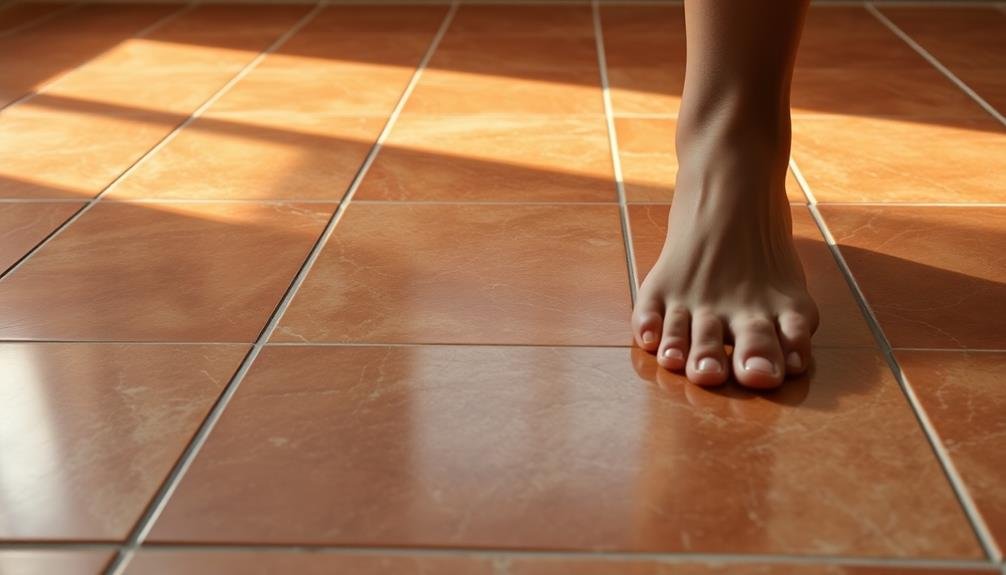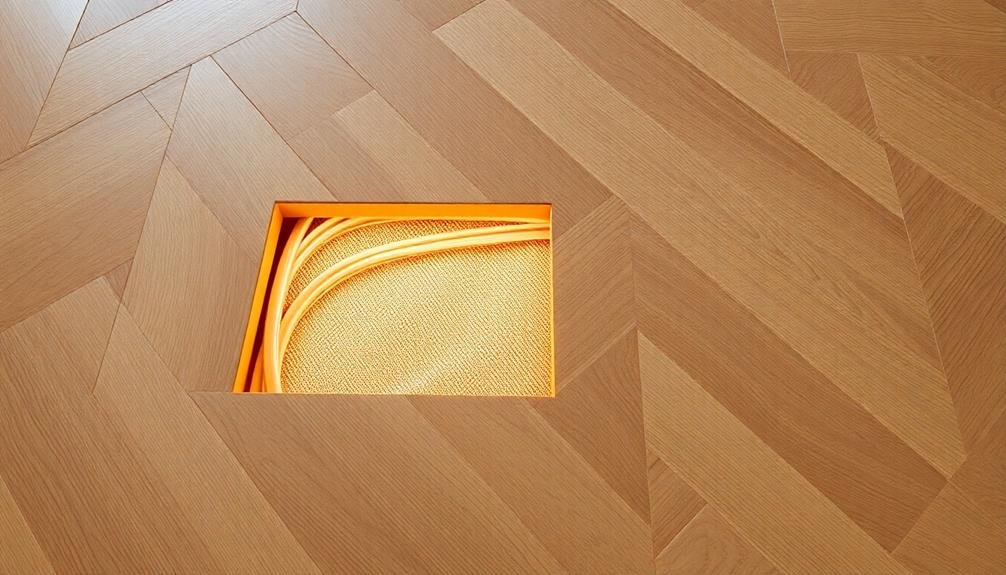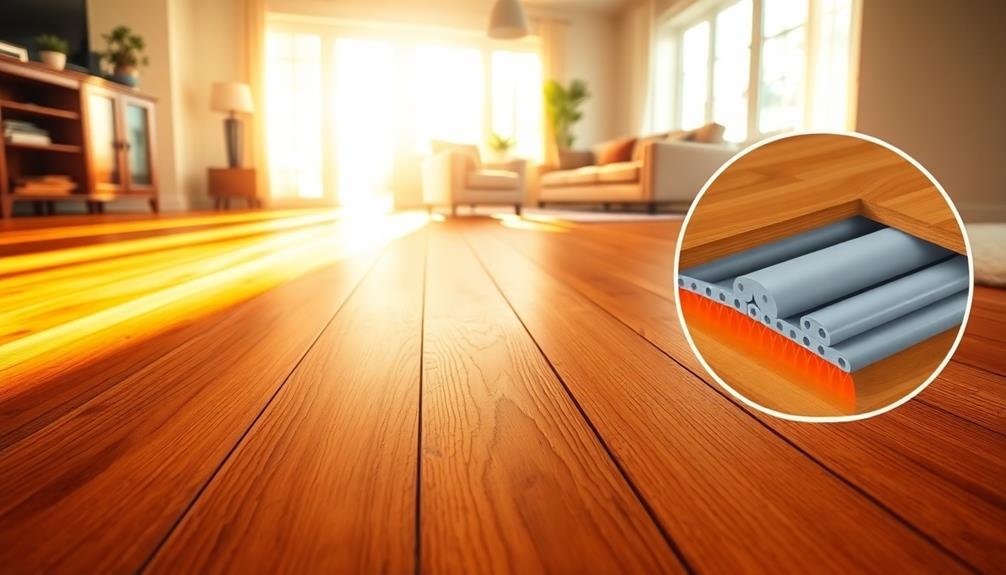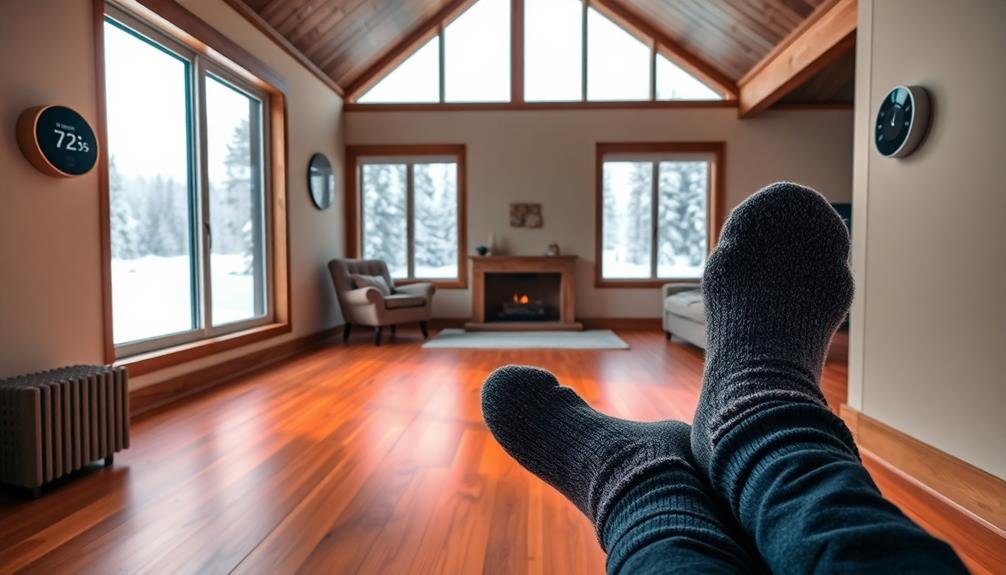When choosing flooring for radiant heat systems, you'll find ceramic and porcelain tile, engineered hardwood, and luxury vinyl planks to be top options. Tile excels in heat conduction and durability, making it ideal for high-traffic areas. Engineered hardwood offers a natural wood look with better stability than solid wood, while luxury vinyl planks provide efficient heat transfer and waterproof properties. Each option has unique benefits, from tile's easy maintenance to hardwood's classic appeal and vinyl's wide range of designs. Consider your specific needs and preferences to determine which flooring will best complement your radiant heating system and lifestyle.
Ceramic and Porcelain Tile

Two of the best flooring options for radiant heat systems are ceramic and porcelain tile. These materials are excellent conductors of heat, allowing the warmth from your radiant system to transfer efficiently into your living space.
They're also durable, water-resistant, and easy to clean, making them ideal for high-traffic areas and rooms prone to moisture.
When you're choosing between ceramic and porcelain, consider that porcelain is denser and less porous, offering superior durability and water resistance. It's an excellent choice for bathrooms, kitchens, and outdoor spaces.
Ceramic tile, while slightly less durable, is often more affordable and comes in a wider variety of colors and designs.
Both types of tile can be installed in various patterns and sizes, giving you flexibility in your design choices. You'll find options ranging from small mosaic tiles to large-format slabs.
Remember to use a flexible adhesive and grout when installing over radiant heat systems to accommodate slight thermal expansion. Additionally, opt for tiles with a matte or textured finish to reduce the risk of slipping on warm, smooth surfaces.
With proper installation, ceramic or porcelain tile will provide an efficient and attractive flooring solution for your radiant heat system.
Engineered Hardwood
While tile offers excellent heat conductivity, many homeowners prefer a warmer, more natural look for their floors. Engineered hardwood provides an excellent alternative that's compatible with radiant heat systems. Unlike solid hardwood, engineered hardwood is more stable and less prone to warping or shrinking when exposed to temperature changes.
When selecting engineered hardwood for radiant heating, consider these factors:
- Wood species: Choose woods with low thermal conductivity, like oak or maple, for better heat distribution.
- Plank thickness: Thinner planks (3/8 to 1/2 inch) allow for more efficient heat transfer.
- Installation method: Opt for a floating floor installation to accommodate expansion and contraction.
Engineered hardwood's layered construction makes it more resistant to moisture and temperature fluctuations than solid hardwood. The top layer provides the natural wood appearance, while the underlying layers offer stability.
You'll need to maintain proper humidity levels (30-50%) in your home to prevent potential issues. Also, be sure to follow the manufacturer's guidelines for maximum temperature settings to avoid damaging the wood.
With proper installation and care, engineered hardwood can be a beautiful, long-lasting flooring option for homes with radiant heat systems.
Luxury Vinyl Planks

A rising star in the world of radiant heat-compatible flooring, luxury vinyl planks (LVP) offer an attractive blend of style, durability, and affordability.
You'll find LVP to be an excellent choice for your radiant heating system, as it conducts heat efficiently while maintaining its structural integrity.
LVP's thin profile allows for ideal heat transfer, guaranteeing your floors warm up quickly and evenly. Unlike natural wood, LVP won't expand or contract with temperature changes, reducing the risk of gaps or warping. This stability makes it ideal for use with radiant heat systems in various rooms, including bathrooms and kitchens.
You'll appreciate LVP's wide range of designs, mimicking the look of wood, stone, or tile. It's also waterproof and easy to clean, making it practical for high-traffic areas.
Installation is straightforward, often featuring click-lock systems that don't require adhesives.
When selecting LVP for radiant heat, choose products specifically rated for this application. Look for options with a wear layer of at least 20 mil for increased durability.
Keep in mind that while LVP performs well with radiant heat, it's crucial to follow manufacturer guidelines for maximum temperature settings to promote longevity.
Frequently Asked Questions
Can Radiant Heating Systems Be Installed Under Existing Flooring?
You can install radiant heating systems under existing flooring, but it's challenging and may require lifting or removing the current floor. It's often easier and more effective to install them during new construction or full renovations.
How Does Radiant Floor Heating Affect Indoor Air Quality?
Radiant floor heating can improve your indoor air quality. You'll experience less dust circulation and reduced allergens since there's no forced air movement. It also maintains consistent humidity levels, creating a healthier, more comfortable living environment for you.
What's the Typical Lifespan of a Radiant Heating System?
You'll be pleased to know that radiant heating systems typically last 15-20 years. With proper maintenance, they can even exceed 30 years. You're making a long-term investment that'll provide reliable warmth for decades to come.
Are There Any Health Benefits Associated With Radiant Floor Heating?
You'll enjoy several health benefits with radiant floor heating. It reduces dust circulation, minimizes allergens, and maintains balanced humidity. You'll also experience improved comfort, better sleep quality, and reduced joint pain due to even heat distribution.
Can Radiant Heating Be Used as the Sole Heat Source?
Yes, you can use radiant heating as your sole heat source. It's efficient and effective, especially in well-insulated homes. You'll enjoy consistent warmth throughout your space, but it's wise to have a backup system for extreme cold.
In Summary
You've explored the top flooring choices for radiant heat systems. Whether you opt for the timeless elegance of ceramic and porcelain tile, the natural warmth of engineered hardwood, or the versatility of luxury vinyl planks, you're sure to find a solution that complements your home's style and heating needs. Remember to consult with a professional to guarantee proper installation and compatibility. With these options, you'll enjoy cozy, efficient heating underfoot for years to come.




Leave a Reply